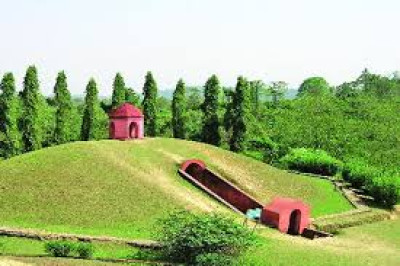Detailed Notes
These sites collectively showcase Assam’s natural wonders and its historical significance, attracting nature lovers, wildlife enthusiasts, historians, and tourists from across the world.
Natural Heritage Sites in Assam
Assam’s natural heritage is renowned for its exceptional biodiversity, including rare and endangered species. Two of the state’s UNESCO designations fall under the Natural category, recognizing their ecological importance.
1. Kaziranga National Park
Kaziranga National Park, located in the Golaghat and Nagaon districts of Assam, is one of the most famous wildlife sanctuaries in India. It was inscribed as a UNESCO World Heritage Site in 1985 for its unique ecosystem and the conservation of endangered species.
The park is globally recognized as the home to the largest population of the Indian one-horned rhinoceros, a species that has faced severe threats from poaching and habitat loss. Kaziranga is also a haven for tigers, elephants, swamp deer, wild water buffalo, and over 450 species of birds, making it a biodiversity hotspot. Its vast floodplains, grasslands, and wetlands provide a perfect natural habitat for these species. The park has earned the reputation of being a model of conservation, blending natural beauty with wildlife protection.
Tourists visiting Kaziranga can explore its elephant safari trails, jeep rides, and bird-watching tours, making it an engaging experience for nature enthusiasts. The park is also significant for ecological studies and research, contributing to global conservation efforts.
2. Manas Wildlife Sanctuary
The Manas Wildlife Sanctuary, straddling the Himalayan foothills and the Assam plains, is another jewel in the state’s natural heritage. Also inscribed in 1985 under the UNESCO Natural category, Manas is famous for its rich biodiversity and scenic beauty.
Manas is a sanctuary of global importance, hosting tigers, wild elephants, pygmy hogs, and golden langurs. Its rivers, dense forests, and grasslands support a wide variety of flora and fauna. In addition to wildlife, the sanctuary is home to several indigenous communities whose lives are intertwined with nature.
The sanctuary also plays a critical role in wildlife migration and ecological balance. For birdwatchers, Manas offers an extraordinary opportunity to spot migratory and endemic bird species, making it a vital site for ornithological studies. Manas Wildlife Sanctuary is also recognized for its successful community-based conservation initiatives, involving local villagers in protecting and preserving the natural habitat.
Cultural Heritage Site in Assam
While Assam’s natural heritage has long been recognized globally, its cultural heritage received a remarkable boost with the inscription of the Moidams – the Mound-Burial System of the Ahom Dynasty in July 2024. This was the first cultural site from Northeast India to receive UNESCO World Heritage status.
3. Moidams – The Mound-Burial System of the Ahom Dynasty
The Moidams are the royal necropolis of the Ahom kings, located in Charaideo, Assam. These mound burial sites reflect the grandeur, sophistication, and unique architectural style of the Ahom Dynasty, which ruled Assam for over six centuries. The Moidams’ design and structure have drawn comparisons to the pyramids of Egypt and royal graves in China, highlighting their significance in global history.
The Moidams consist of earthen mounds and elaborate burial structures, constructed to honor the deceased kings and their royal lineage. The site provides invaluable insights into Ahom architecture, funerary customs, and historical traditions. Its inclusion in the UNESCO World Heritage list emphasizes the importance of preserving Northeast India’s cultural and historical landmarks, which were previously less recognized on the international stage.
For historians, archaeologists, and tourists, the Moidams offer a glimpse into Assam’s royal past and an opportunity to explore the rich cultural heritage that shaped the region over centuries.
Significance of Assam’s UNESCO Sites
The recognition of these three UNESCO World Heritage Sites underscores Assam’s dual legacy: ecological richness and cultural excellence. Kaziranga and Manas highlight the state’s efforts in wildlife conservation, habitat protection, and biodiversity management, while the Moidams celebrate the Ahom Dynasty’s historical achievements and cultural heritage.
These sites contribute to Assam’s tourism, education, and global recognition. They also serve as examples of sustainable conservation practices, community involvement, and heritage preservation. Visitors from across India and the world are drawn to Assam not only for its natural beauty and wildlife but also for the unique cultural experiences offered by sites like the Moidams.
Visitor Information & Tourism
-
Kaziranga National Park: Best visited from November to April; elephant safaris are recommended for close wildlife viewing.
-
Manas Wildlife Sanctuary: Accessible via road and offers eco-tourism and bird-watching opportunities.
-
Moidams of Ahom Dynasty: Visit Charaideo to explore the royal burial mounds and nearby historical monuments.
Assam’s UNESCO sites are also integrated into educational programs, ecological research, and heritage tours, making them valuable for students, scholars, and travelers.
Conclusion
Assam’s UNESCO World Heritage Sites – Kaziranga National Park, Manas Wildlife Sanctuary, and the Moidams of the Ahom Dynasty – collectively showcase the state’s unparalleled natural and cultural heritage. From endangered wildlife and biodiversity hotspots to royal tombs and historical architecture, these sites reflect the rich legacy of Assam. For anyone interested in nature, history, and culture, visiting these UNESCO sites provides a once-in-a-lifetime experience that blends education, exploration, and adventure.
Whether you are preparing for competitive exams, planning a tour, or simply expanding your knowledge, understanding Assam’s UNESCO World Heritage Sites is essential to appreciate the state’s ecological importance and cultural richness.
